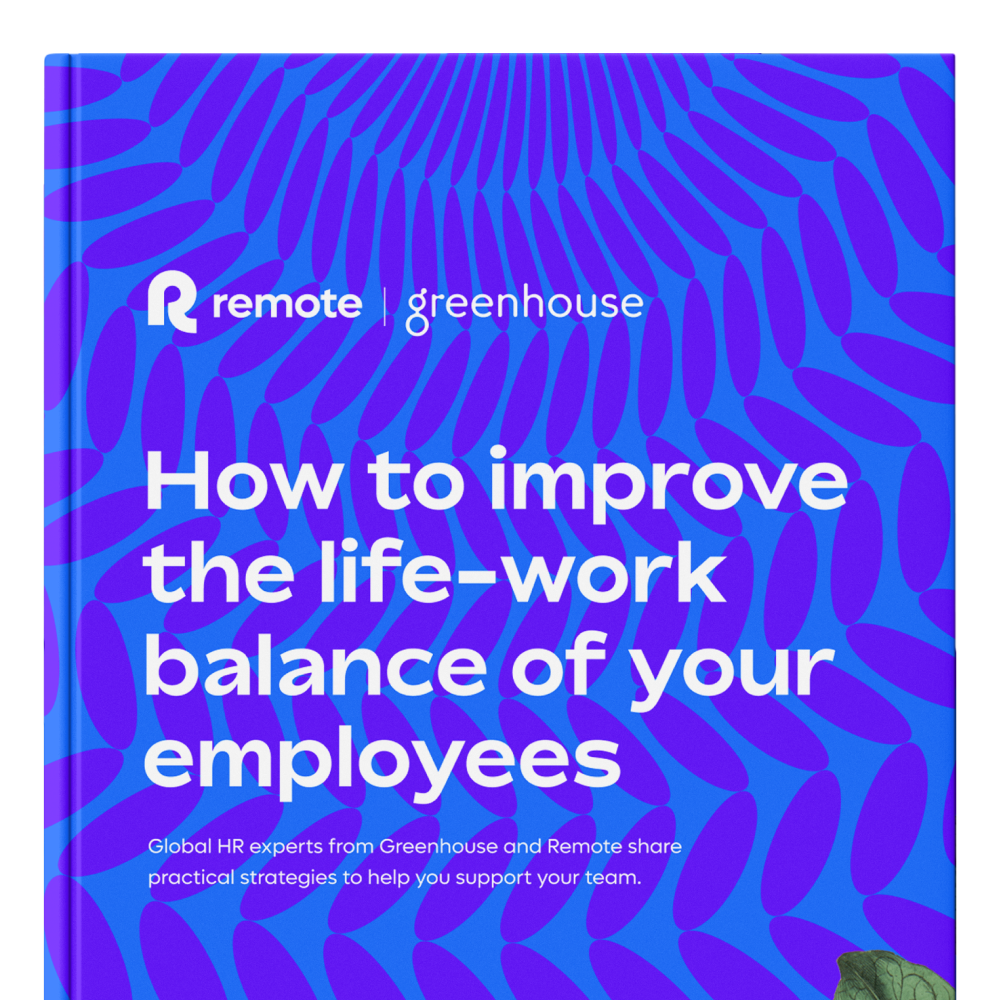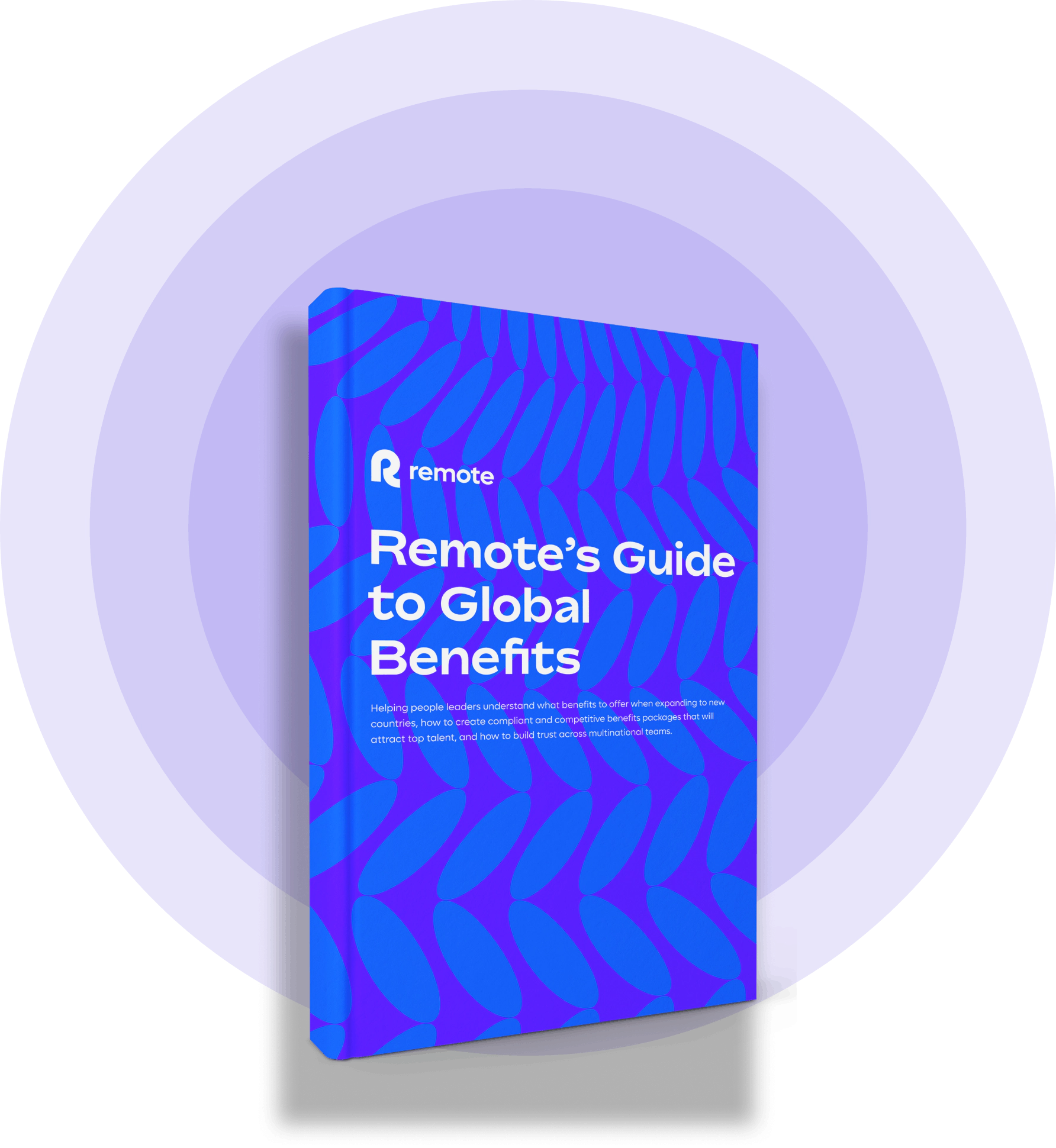
Product Updates — 7 min

Benefits & Leave — 27 min
The way we work is constantly changing. So, employers need innovative ways to attract and retain new and top-performing talent. Introducing flexible working practices and offering value-based company benefits are just two of the ways you can do that.
With this in mind, Remote conducted a study to help you understand the importance of employee retention and what you can do to keep your best people.
We surveyed employers in the UK and the US to investigate how turnover rates have changed in the last few years, the negative impacts of high turnover, and the job functions and levels struggling to retain top talent.
In this article, we cover the key takeaways from our study that you can implement.
By analyzing employee turnover metrics, you can make informed decisions about compensation, benefits, training programs, and workplace policies. A low turnover rate keeps your business running successfully and smoothly.
In our survey, almost two-thirds (63%) of employers agreed that having low turnover rates increases motivation within the company. Higher levels of motivation help you maximize productivity.
A further 61% of employers said that low turnover rates improve several other aspects of workplace performance:
Increased morale within the company
Enhanced employee experience
Strengthened loyalty to the team
Deeper connections among workers
Better job satisfaction
Additionally, six in 10 of the employers we spoke to said low turnover rates decrease operational costs. A further 59% stated that time spent on training is reduced when the turnover rate is low.
Learn practical insights from global HR experts at Greenhouse and Remote to help you support your team's life-work balance

The top 10 benefits of low turnover rates, according to employers:
Rank | Benefit | % of employers who agree |
1 | Increase motivation | 63% |
2 | Improve morale | 61% |
3 | Increase employee loyalty | 61% |
4 | Improve employee experience | 61% |
5 | Allows deeper connections among employees | 61% |
6 | Improve company culture | 60% |
7 | Reduce costs | 60% |
8 | Reduce time spent on training | 59% |
9 | Lead to employee-driven innovation | 59% |
10 | Improve communication | 59% |
On average, employee turnover rates have increased by 8.7% since 2019. The rates in the US have been higher every year, seeing an increase of 9.6% since 2019. The UK rates, while lower, have still increased by 7.7% in the last four years.
The average company turnover rate in the UK and the US from 2019 to 2022
Year | UK | US | Average |
|---|---|---|---|
2019 | 25.8% | 34.3% | 30.3% |
2020 | 29.7% | 36.9% | 33.4% |
2021 | 31.6% | 40.3% | 36.1% |
2022 | 33.6% | 43.9% | 38.9% |
Flexible work models can have a direct impact on retention rates. To investigate, we asked the owners of office-only, hybrid, and remote businesses to report on their turnover rates throughout the years to see how they compared.
The average turnover rate of different work models in the UK and the US from 2019 to 2022
Year | Office | Hybrid | Remote |
2019 | 30.1% | 29.8% | 33.0% |
2020 | 34.9% | 31.7% | 34.8% |
2021 | 38.5% | 34.4% | 34.4% |
2022 | 41.6% | 36.6% | 38.7% |
Companies that have a hybrid or flexible work model had the lowest overall turnover rates since 2019. The rates peaked in 2022 with a 5% lower turnover rate than those that are fully office-based.
Flexible working encourages trust and autonomy among employees. This has a positive impact on their likelihood of staying at the organization. The significant increase in turnover rates for companies with an on-premise business model highlights this trend. From 2019 to 2022, average turnover rates for office-based workers increased by 11.5%.
Fully remote roles also offer a breadth of benefits for both employees and employers: from saving money on commute travel, having more time for activities outside of work, and also attracting talent from all across the world. These factors affect retention and are cost-effective for both parties.
Employee turnover rates can vary across certain industries and job functions. A competitive job market or a demanding role can disrupt employees' work-life balance and cause them to leave.
To explore more, we asked businesses across the UK and the US to report on the average turnover rates in each of their company's departments.
The average turnover rate of business departments in the UK and the US
| Job function | UK 2021 | US 2021 | Average 2021 | UK 2022 | US 2022 | Average 2022 | % Average change |
|---|---|---|---|---|---|---|---|---|
1 | Product | 30.3% | 39.1% | 34.8% | 32.2% | 40.3% | 36.4% | 1.6% |
2 | Information Technology | 28.7% | 39.2% | 34.1% | 30.2% | 41.7% | 36.0% | 2.0% |
3 | Engineering | 28.7% | 38.2% | 33.6% | 29.4% | 40.6% | 35.2% | 1.6% |
4 | Finance / Accounting | 28.2% | 37.4% | 31.9% | 30.5% | 39.5% | 35.2% | 3.3% |
5 | Sales | 31.1% | 39.9% | 35.6% | 31.0% | 38.9% | 35.1% | -0.5% |
6 | Marketing/PR | 28.3% | 38.2% | 33.4% | 29.2% | 39.1% | 34.3% | 0.9% |
7 | HR/People | 28.3% | 36.2% | 32.4% | 28.3% | 39.9% | 34.2% | 1.8% |
8 | Design | 28.2% | 38.5% | 33.5% | 30.0% | 38.1% | 34.1% | 0.6% |
9 | Customer service/support | 28.7% | 39.7% | 34.1% | 28.3% | 39.3% | 33.9% | -0.2% |
10 | Legal | 26.2% | 38.6% | 32.6% | 28.1% | 39.5% | 33.9% | 1.3% |
11 | Administration/operations | 27.7% | 38.9% | 33.5% | 28.0% | 39.1% | 33.8% | 0.3% |
In 2021, sales was the job function with the highest employee turnover in both the UK and the US, with a turnover of 31.1% and 39.9%, respectively. The average turnover rate for sales has dropped since then, going from 35.6% in 2021 to 35.1% in 2022.
This changed in 2022, with jobs in ‘product’ departments having the highest turnover in the UK, with a 32.2% rate. Information technology jobs came in top in the US, with an average of 41.7% of employees leaving.
Finance and accounting roles have seen the biggest average increase in turnover, with a 3.3% higher rate in 2022 compared to 2021. Customer service and sales roles are the only jobs that have seen a decrease in their employee turnover, with rates falling by 0.2% and 0.5%, respectively.
On the flip side, legal jobs had the lowest turnover rates in the UK in both 2021 and 2022. The US saw the lowest turnover in employees in HR jobs in 2021 and then design jobs in 2022.
Retaining top talent at all job levels can be a challenge for businesses to overcome, and employee turnover can vary significantly.
In 2021, director roles had the highest turnover rate at 35%. However, 2022 saw the highest turnover rate in entry-level positions at 35%.
Job Level | Average turnover as a percent of total employees 2021 | Average turnover as a percent of total employees 2022 |
Entry-level (intern, trainee, apprentice, assistant) | 34.4% | 35.0% |
Individual Contributor (representative, specialist, analyst, coordinator, administrator, consultant, associate, generalist) | 32.5% | 32.9% |
Manager | 32.9% | 33.4% |
Senior Manager | 32.8% | 34.1% |
Director | 35.1% | 34.6% |
Vice President | 34.0% | 33.7% |
CEO | 34.3% | 34.0% |
Department-wise, education and healthcare had the highest turnover in higher-up roles. Healthcare experienced the highest turnover for director-level jobs in both 2021 and 2022, vice president roles in 2022, and CEO roles in 2022.
Education had the highest average turnover in vice president roles in 2021 and CEO roles in 2022.
IT and telecoms departments had the highest turnover in lower-level roles, with the highest turnover in entry-level positions in 2022, manager positions in 2021, and senior manager positions in 2021 and 2022.
We asked employers what they believe causes high turnover rates.
Over half (54%) agreed that a poor work-life balance can lead to high turnover. A further 53% said that lack of work flexibility can contribute to employees' decision to leave.
Fifty-two percent of employers shared that overwork can also be a contributing factor. The same amount also said that a lack of employee benefits can lead to high turnover rates in companies.
The top 10 causes of high employee turnover
Rank | Cause of high employee turnover rate | % of employers |
1 | Organizational restructuring | 55% |
2 | Poor work-life balance | 54% |
3 | Personal circumstances | 54% |
4 | Lack of work flexibility | 53% |
5 | Lack of employee benefits | 52% |
6 | Being overworked | 52% |
7 | Lack of innovation | 51% |
8 | Lack of employee purpose | 50% |
9 | No feedback or recognition | 50% |
10 | Poor compensation rates | 50% |
Employers should support their employees’ work-life balance to reduce employee turnover rates. A simple and cost-effective solution is the introduction of a flexible working policy. This allows employees to spend less time commuting and more time in their homes and be in ownership of their schedules.
Stronger health and well-being benefits are another great way employers can retain their staff by showing they care for and respect their employees.
For employers, losing staff means losing valuable employee knowledge and experience of the company and internal processes. As a ripple effect, existing employees can face a variety of pressures, such as low morale, overwork during the hiring process for a replacement, decreased productivity, and even burnout.
High turnover can also result in a costly process to find and recruit new staff. The time required from multiple stakeholders to recruit, onboard, and train new starters is significant. If a fraction of this resource is redeployed into intentional retention practices to better support existing top performers, the long-term productivity benefits lead to sustained success.
According to the employers we surveyed, it costs an average of 35% of an employee’s salary to find and hire a new worker for the business. This expense can spiral if multiple employees leave or are terminated over time.
In the UK, it costs around 26.1% of an employee's salary to find and hire a new member of staff; that’s an average of £7,729 per new employee based on the average UK annual salary.
In the USA, it costs around 42.7% of an employee’s salary to find and hire someone new. Based on the average salary in the US, this costs businesses $22,814 on average to find a new staff member.
Hiring someone new takes time and money. Businesses spend an average of 40 days to find an appropriate new candidate. In the UK, it takes an average of 39 days, and in the US, it takes slightly longer at 40 days.
Finding a new hire takes the longest in IT and telecoms jobs, with an average of 49 days needed to replace an employee who has left. The education industry takes the second longest time to hire new staff, with an average of 44 days. This is followed closely by sales, media, and marketing roles, which take an average of 42 days.
The travel and transport industry replaces employees in the shortest amount of time, taking just 23 days.
Remote's global HR experts share practical advice for building a locally relevant and globally compliant benefits program to help you attract and keep the world's best talent.

We asked employers what helped them reduce their companies’ turnover rates. Here were the top 10 answers.
The top 10 ways to reduce high employee turnover, according to employers
Rank | Policies that reduce turnover rate | % of employers |
1 | Developing career paths and opportunities for progression | 63% |
2 | Increasing salaries | 60% |
3 | Giving paid overtime | 58% |
4 | Asynchronous or flexible working | 58%
|
5 | Improving internal communication and transparency | 58% |
6 | Recognizing and rewarding employees | 58% |
7 | Standardizing performance reviews | 58% |
8 | Remote or hybrid working | 57% |
9 | Providing private health care or covering medical insurance | 57% |
10 | Increasing the number of paid holidays | 56% |
Almost two-thirds of employers said businesses can increase employee retention rates by developing career paths and giving their employees opportunities for progression.
Six in 10 employers said increasing salaries has helped them reduce turnover.
Offering asynchronous or flexible working helped another 58% of employers reduce turnover, along with improving internal communication and transparency within the business.
That said, what are some of the best practices you can follow to reduce employee turnover based on the above findings?
Organizations can cultivate a positive work environment, improve employee loyalty, and ultimately reduce the costly cycle of employee attrition by implementing effective retention strategies.
Below, we list some ways to decrease employee turnover rates. Let’s look at some of those in detail, plus a few more tips.
Insights from 2,500+ decision makers and employees in key markets to help you uncover the benefits your team want and need in 2023.

Before you start hiring, know the skills, qualifications, and experience each position requires. This information guides your recruitment efforts, helping you attract and hire candidates. When you take on the right people for the right jobs, they are more likely to thrive and want to stay with your organization.
Onboarding programs aren’t just about completing formalities or doing introductions. Provide new hires with comprehensive training, assign them mentors, and share the values and vision of your company. That can help boost engagement and retention.
Having competitive salaries prevents employees from looking elsewhere. Increasing salaries to reward excellent performance also helps. Of course, increasing salaries across the board can be an expensive proposition. Many companies create global compensation plans to find great international talent and develop a distributed workforce more sustainably.
Plus, hiring in multiple countries is easier, faster, and more secure if you use an employer of record partner to manage cross-border compliance and payroll.
When team leaders provide clear opportunities for progression, employees feel like their company invests in their future and cares about their personal development.
Regular check-ins, feedback loops, and 1-on-1s with staff inspire employees and increase their motivation to do great work. Plus, when employees feel heard, they're more likely to stick around.
Whenever possible, offer options for remote and asynchronous work, flexible schedules, or compressed workweeks. This accommodation can greatly improve work-life balance and employee satisfaction.
Everyone likes being appreciated for hard work. Establish formal programs to recognize and reward outstanding performance, such as employee of the month awards, spot bonuses, or public praise at team meetings.
Involve your team in decision-making processes that impact their work. Seek their input and feedback regularly. When employees feel invested in the company's success, they're less likely to look elsewhere for opportunities.
Identify high-potential employees and provide them with opportunities for growth and leadership training. Not only does this create a talent pipeline, but it also shows them your commitment to their professional development.
Build a culture where employees feel respected, heard, and accepted regardless of their backgrounds, beliefs, or circumstances. Provide diversity and inclusion training, celebrate different cultures and holidays, and ensure equal opportunity for all.
Employee burnout and stress often lead to high turnover. Offer wellness opportunities, like gym memberships, yoga classes, counseling services, or employee assistance programs. Little perks, like healthy office snacks and standing desks, can also work. The key is making employee well-being a consistent priority, not just a one-off initiative.
The key to reducing employee turnover lies in creating an attractive, supportive, and growth-oriented work environment. By implementing the strategies outlined above, employers can significantly improve job satisfaction and retention rates.
This is where Remote comes in as a valuable partner. With it, you can:
Onboard and pay employees globally, guaranteeing full compliance with local labor laws and regulations
Offer competitive compensation packages, including benefits tailored to specific regions, improving your likelihood of retaining valuable employees
Reduce the administrative burdens associated with managing a global workforce, allowing you to concentrate your efforts on creating a positive work environment
We are the top choice for thousands of companies around the world, and we'd love to help you grow your global team with confidence and security.
Want to learn more about how Remote can help you attract and retain a skilled and diverse workforce? Talk to one of our friendly experts today.
Trust Remote’s global HR experts to build curated, locally compliant benefits packages at globally competitive rates.

We surveyed over 544 employers in December 2022.
Please note, employee turnover rates refer to the turnover as a percent of total employment. This is calculated by dividing the total number of leavers in a year by your average number of employees in a year. Then, times the total by 100.
Subscribe to receive the latest
Remote blog posts and updates in your inbox.

Product Updates — 7 min

Global Payroll — 2 min

Minimum Wage & Compensation — 7 min

Newsroom — 5 min